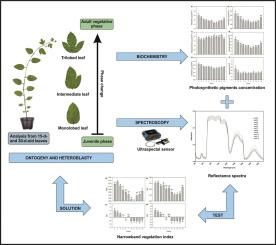Journal of Photochemistry and Photobiology B: Biology ( IF 5.4 ) Pub Date : 2020-06-10 , DOI: 10.1016/j.jphotobiol.2020.111931 Amanda Mendes Fernandes 1 , Evandro Alexandre Fortini 1 , Larissa Areal de Carvalho Müller 1 , Diego Silva Batista 2 , Lorena Melo Vieira 1 , Priscila Oliveira Silva 3 , Cibele Hummel do Amaral 4 , Richard Scott Poethig 5 , Wagner Campos Otoni 1

|
During shoot development, leaves undergo various ontogenetic changes, including variation in size, shape, and geometry. Passiflora edulis (passionfruit) is a heteroblastic species, which means that it experiences conspicuous changes throughout development, enabling a morphological distinction between the juvenile and adult vegetative phases. Quantification of heteroblasty requires a practical, inexpensive, reliable, and non-destructive method, such as remote sensing. Moreover, relationships among ontogenetic changes and spectral signal at leaf level can be scaled up to support precision agriculture in passion fruit crops. In the present study, we used laboratory spectroscopic measurements (400–2500 nm) and narrowband vegetation indexes (or hyperspectral vegetation indexes – HVIs) to evaluate ontogenetic changes related to development and aging in P. edulis leaves. We also assessed leaf pigment concentration to further support the application of biochemical-related narrowband indexes. We report that 30-d-old leaves can be discriminated into developmental stages through their spectral signals. MSI (Moisture Stress Index) and NDVI750 (Normalized Difference Vegetation Index ρ750) contribute most to the variation of age (15 to 30-d-old leaves) and developmental stage (phytomer positions along the plant axis) in passionfruit leaves. PRI (Photochemical Reflectance Index) played an important role in detecting age and development alterations, including heteroblasty. A biochemical and spectral comparison of pigments revealed that spectroscopy offered potential for diagnosing phenology in P. edulis, as some narrowband indexes correlated strongly with chlorophylls and carotenoids content. Narrowband vegetation indexes are found to be a suitable tool for monitoring passionfruit crops.
中文翻译:

通过窄带光谱信号检测西番莲(Passiflora edulis Sims。)叶片发育阶段和个体发育变化。
在枝条发育期间,叶片会经历各种个体发育变化,包括大小,形状和几何形状的变化。西番莲(百香果)是一种异胚性物种,这意味着它在整个发育过程中都会经历明显的变化,从而在幼年和成年植物营养期之间形成了形态上的区别。异源爆炸的量化需要一种实用,廉价,可靠且无损的方法,例如遥感。此外,可以扩大叶片水平上个体发育变化与光谱信号之间的关系,以支持百香果作物中的精确农业。在本研究中,我们使用实验室分光光度法(400–2500 nm)和窄带植被指数(或高光谱植被指数– HVI)来评估与可食假单胞菌发育和衰老相关的个体发育变化。树叶。我们还评估了叶色素的浓度,以进一步支持与生化相关的窄带指标的应用。我们报告说,可以通过其光谱信号将30天大的叶子区分为发育阶段。MSI(水分胁迫指数)和NDVI 750(归一化植被指数ρ750)对百香果叶片的年龄(15至30 d大叶片)和发育阶段(沿植物轴的植物体位置)的变化贡献最大。PRI(光化学反射率指数)在检测年龄和发育变化(包括异胚细胞)中起着重要作用。色素的生化和光谱比较显示,光谱学为诊断可食的体育现象提供了潜力,因为一些窄带指数与叶绿素和类胡萝卜素含量密切相关。发现窄带植被指数是监测百香果作物的合适工具。



























 京公网安备 11010802027423号
京公网安备 11010802027423号